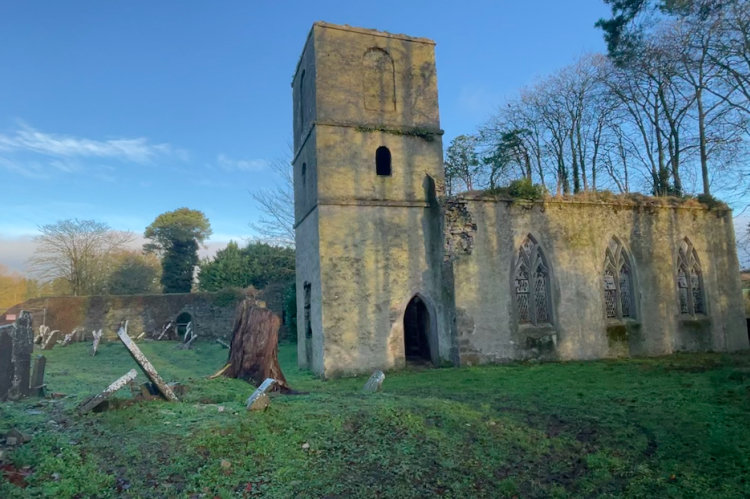Apr
17
2023
This church and graveyard are in the townland of Clenor North, and now part of Killavullen parish. It is in the civil parish of Clenor and in the barony of Fermoy. It is a former Church of Ireland church.
It is located on the north side of the Blackwater River, on the N73 Mitchelstown/Mallow road. It is approximately 2km south of Doneraile.
The present ruined church is dated to 1813 and is located south of the centre of the graveyard. It is roofless and the walls are rendered over random-rubble limestone.
There is a three storeyed tower at the west end. The ruins of an earlier Medieval church are located in the north west corner of the graveyard. Only the south wall is standing.The interior of the ruined church is filled with burials and mortuary monuments.
The graveyard is sub-rectangular in shape with a curved boundary to the north/north East. It is enclosed by a stone wall and the entrance is marked by limestone piers and fine wrought-iron gates. The graveyard was in use for burials up to the late 1980’s.
The oldest memorials are in the northern half of the graveyard. The oldest headstone dates to 1711. It is to Ellen Gordan but there are two others from 1719 and 1720 in the same area. John Daly, who died aged 54 in 1719 and Cornelius Fling from 1720. Fling is how Flynn was pronounced at the time. You will still hear those old surname pronounciations in pockets of the countryside.
Almost a 100 memorials have been recorded.
Surnames recorded include Pine, Healy, Numan, Sullivan, Barrett, Wall, Roche, O’Brien and Nugent.
Interesting facts
St. Cranat is the patron saint of the ancient parish of Clenor. During the first half of the 19th century, the 9th March was ‘Pattern Day’ each year when prayers were said at St. Cranat’s Well. This well is located in the nearby townland of Gurraneachole, about 2km south of Skenakilla Crossroads. The waters were believed to have healing properties. People drank and bathed their faces in the water.
Clenor is the name derived from the Irish name Crann a Hulla, the sacred tree of Clenor. It refers to a very old ash tree growing in the nearby townland of Annakisha.
A pious young woman named Cranat had decided to dedicate her life to God, having made a vow to St. Brigid. Her beauty had attracted the interest of the Prince of Munster and he wanted to make her his bride. With firm resolve, she plucked out one of her eyes. It is said that immediately a big strong ash tree sprang up in the spot where her eye had fallen. No longer beautiful, he left her be. The same tree is still there.
This post was researched and written as part of a grassroots heritage tourism project (www.incultum.eu) in collaboration with Ballyhoura Development CLG (https://www.ballyhouradevelopment.com/), Cork Co. Council (https://www.corkcoco.ie/en) and Limerick Co. Council (https://www.limerick.ie/council). The stories were initially gathered during a community survey of the graveyard. They form part of the Historic Graves Project Destination for Ballyhoura (https://historicgraves.com/destination/ballyhoura).



